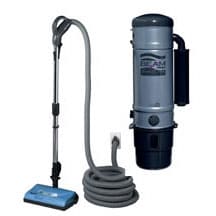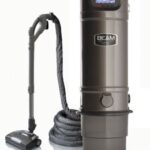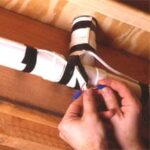In addition to being handy, central vacuums reduce allergy symptoms and do an excellent job of vacuuming.
Because the vacuum canister can be larger than a conventional household vacuum’s, it can do a more powerful job of collecting dust, pollen, dander, and other airborne pollutants without re-circulating those allergens into living spaces the way a conventional, portable vacuum cleaner does.
And even though central vacuums are larger and more powerful than conventional vacuums, they are quieter because the motor is remote.
How a Central Vacuum System Works
With a built-in central vacuum system, you do not have to lug a heavy vacuum cleaner from room to room or up and down stairs. Instead, you just tote around a cleaning attachment on the end of a long, lightweight hose. To vacuum, you plug the hose into any of several wall- or floor-mounted receptacles. Dust and debris travel through the hose into the receptacles and then to a remote canister by a system of hidden plastic pipes. The vacuum canister is typically located in the basement or garage.
For more about how central vacuum systems work, complete with an illustrated diagram, see How a Central Vacuum System Works.
Central Vacuum System Buying Guide
The trick to buying the right central vacuum system for your home is making sure it is sized correctly, not only for the square footage of your house but also for the length of pipe required to service the system. The most important rating to look for is “waterlift,” which refers to the system’s sucking power. This will determine how well the vacuum can draw the dirt through all of the piping.
Central vacuum systems cost from $600 to $1,500, depending on the size, amount of piping needed, and power. Most dealers quote a price including installation, so make it clear if you plan on doing the installation yourself.
For more information, see the Central Vacuum System Buying Guide.
How to Install a Central Vacuum System
Installing a central vacuum system is infinitely easier to do in new construction, but a system can be retrofitted into an existing home with relative ease as long as there is adequate access to a basement, crawlspace, or attic. The four main components are the power unit (which also includes the dirt-collection bin), usually installed in a garage, basement, or utility room; the inlet valves; PVC tubing; and a lightweight hose with the cleaning wand.
For step-by-step instructions with illustrative photographs on how to install a central vacuum system in both new construction and an existing home, see How to Install a Central Vacuum System.
Featured Resource: Get a Pre-Screened Local Central Vacuum Pro








 Don Vandervort writes or edits every article at HomeTips. Don has:
Don Vandervort writes or edits every article at HomeTips. Don has:

